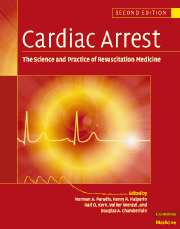Book contents
- Frontmatter
- Contents
- List of contributors
- Foreword
- Preface
- Part I Introduction
- Part II Basic science
- Part III The pathophysiology of global ischemia and reperfusion
- Part IV Therapy of sudden death
- Part V Postresuscitation disease and its care
- Part VI Special resuscitation circumstances
- Part VII Special issues in resuscitation
- 66 The ethics of resuscitation and end of life decisions
- 67 The economics of treating sudden cardiac arrest
- 68 Medicolegal aspects
- 69 The near-death experience, long-term psychological outcomes and support of survivors
- 70 CPR training
- 71 Consensus development in resuscitation: the growing movement towards international emergency cardiovascular care guidelines
- Index
71 - Consensus development in resuscitation: the growing movement towards international emergency cardiovascular care guidelines
from Part VII - Special issues in resuscitation
Published online by Cambridge University Press: 06 January 2010
- Frontmatter
- Contents
- List of contributors
- Foreword
- Preface
- Part I Introduction
- Part II Basic science
- Part III The pathophysiology of global ischemia and reperfusion
- Part IV Therapy of sudden death
- Part V Postresuscitation disease and its care
- Part VI Special resuscitation circumstances
- Part VII Special issues in resuscitation
- 66 The ethics of resuscitation and end of life decisions
- 67 The economics of treating sudden cardiac arrest
- 68 Medicolegal aspects
- 69 The near-death experience, long-term psychological outcomes and support of survivors
- 70 CPR training
- 71 Consensus development in resuscitation: the growing movement towards international emergency cardiovascular care guidelines
- Index
Summary
Introduction
Clinical guidelines aredefinedby the Institute ofMedicine in the United States as“systematically developed statements to assist practitioner and patient decisions about appropriate health care for specific clinical circumstances.” The main objective of guidelines is to improve the quality of care received by patients by closing the gap between what clinicians do and what scientific evidence supports. Guidelines provide a point of referencefor auditing performanceof clinicians or hospitals and may improve effectiveness and efficiency. The development of guidelines requires appropriate resources: expert clinicians, group process leaders, and financial support. All these statements refer to guideline development in general, but they are particularly relevant to the development of resuscitation guidelines that have existed for at least 40 years. The steps involved in the process for developing evidence-based guidelines have been outlined by the Grades of Recommendation Assessment, Development and Evaluation (GRADE) Working Group (Table 71.1).
This chapter will review the history of consensus development in resuscitation, the role of the International Liaison Committee on Resuscitation (ILCOR), the process involved in undertaking a systematic review of resuscitation science, and the writing of clinical guidelines based on a consensus of the science.
The history of international CPR consensus and guideline development
The modern approach to cardiopulmonary resuscitation (CPR) was described in the late 1950s and early 1960s. Although this was undoubtedly the birth of CPR, it was immediately realized that the challenge was to spread the word and educate healthcare workers and laypeople throughout the world. This same challenge faces us today whenever CPR guidelines are modified and updated.
- Type
- Chapter
- Information
- Cardiac ArrestThe Science and Practice of Resuscitation Medicine, pp. 1278 - 1288Publisher: Cambridge University PressPrint publication year: 2007



